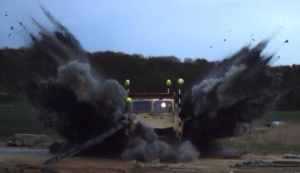Articles >>
Further Blast Testing is conducted on the Supacat SPV400
Category: Defence Industry

The Supacat SPV400, the all-British, all-new contender from Supacat to meet the UK Ministry of Defence`s Light Protected Patrol Vehicle (LPPV) requirement was, this week, subjected to a second round of blast tests as part of the vehicle’s development programme. A number of blast tests were conducted to correlate development work and prove the upgrades and improvements incorporated into the SPV400 design since the first round of testing in December 2009. The results were very positive and consistent with expectations. Whilst for security and competitive reasons the detail cannot be released, the size of the blasts were “very significant” and underwrote Supacat’s philosophy of future proofing the SPV400 design by aiming for protection levels above those within the LPPV requirement. Further refinement will now take place prior to another round of testing next month. The SPV400's integrated protection system comprises of a composite crew pod, developed in conjunction with NP Aerospace, mounted on a V-shaped hull with sacrificial subframes front and rear housing the engine and axles. With the primary blast focussed under the belly of the vehicle, the integrated V-shaped hull successfully deflected the majority of the blast away from the vehicle proving the SPV400's crew and system survivability capabilities. Additional testing focussed away from the central V-shaped hull also proved Supacat’s approach when mounting the axles in sacrificial sub-frames fore and aft of the hull. "These tests have once again proven Supacat's design philosophy for delivering a state of the art light protected patrol vehicle providing the protection and mobility our soldiers need for 21st Century operations", said Nick Ames, Managing Director, Supacat Ltd. “We have now proven that the SPV400 can provide levels of protection way in excess of anything seen previously in vehicles of this size and weight. Having said that, there is yet more that can be achieved and our team are now working hard to enable that”. A new component of the latest tests was the introduction of post-test formal repair analysis to prove the ability to repair the SPV400. The results confirmed that the same test vehicle could be quickly repaired after each blast. “I am particularly pleased with the repair aspects of this testing as our offering has been designed to reduce through life costs by having the ability to be repaired in theatre. The modular and sacrificial approach reduces overall damage to the system and will allow LPPVs to be put back on the road quickly. With the SPV400, the MoD will not have to write a vehicle off each time there is a mine strike”, said Nick Ames. Vehicle 01 was subjected in December 2009 to two days of blast trials, which included a 'significant' under vehicle mine blast simulation as well as a "huge" Vehicle Borne Improvised Explosive Device (VBIED) simulation. Vehicle 04 in the SPV400 development programme underwent these latest blast tests and Vehicle 05 is being completed at Supacat’s Devon facility in readiness to undergo further blast tests next month. The UK Ministry of Defence purchased two vehicles from Supacat, Vehicle 02 and 03, to participate in trials and risk reduction activities for the LPPV Programme. The SPV400 Series
The SPV400’s modular design optimises survivability and mobility within the LPPV specification for a 7.5 ton vehicle carrying a crew of six (2 +4). The SPV400 has an armoured steel V-shaped hull that deflects the blast away from the crew pod which is blast and ballistic protected using the latest composite and ceramic armour systems. The crew pod is constructed as a separate module, sealed off from potential secondary projectiles, such as kit and electronic devices, which are housed in a rear compartment. All seats are mine blast protected. Additional protection is provided by the front and rear axles, which are mounted on detachable `sacrificial` sub-frames to absorb and deflect a blast away from the crew pod if a wheel strikes an explosive device. To enable this approach, the engine and transmission are separated to ensure the crew pod is not impacted should the front sub-frame detach. This modular approach also enables rapid in-theatre repair should a vehicle be involved in an incident. The affected module(s) can be quickly replaced enhancing the availability and maintainability of deployed platforms. The SPV400’s speed and all terrain mobility is comparable to Jackal and it is capable of 80mph on desert plain. Air suspension provides troops with a smooth ride, reducing crew fatigue, and the manoeuvrability has been optimised to allow troops to operate in the tightest of terrain. About Supacat
Supacat specialises in the design and development of high mobility vehicles and other specialist transport systems for military and civil customers. The company was founded in 1981 to develop the Supacat 6x6 high mobility vehicle and is a UK centre of excellence in all terrain transport technology. From its facility at Dunkeswell, Devon, UK, it employs 120 people across a range of engineering disciplines, including design, testing and prototype manufacture through to maintenance, repair and overhaul and low rate production. It provides a complete support management service for its own as well as other manufacturers’ vehicles. Supacat designed the Jackal weapons-mounted, long-range patrol vehicle and the 6x6 Coyote Tactical Support Vehicle (Light) – both variants of the High Mobility Transporter (HMT) concept designed by Supacat and built under licence from Lockheed Martin. Currently in service with British Forces there are over 260 Jackal 2, 200 Jackal 1 and over 70 Coyote vehicles. |
Supacat |
Supacat, Rheinmetall and SCISYS partnership showcases new High Mobility Integrated Fires Capability
12.09.2019
UK company pioneers autonomous hybrid vehicle for extreme off road operations
12.09.2019
Supacat delivers the first production HMT Extenda Vehicle to Norway
21.06.2018
Ocelot LPPV/Foxhound (Mine protected carrier)
Discuss
